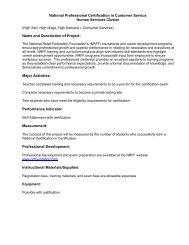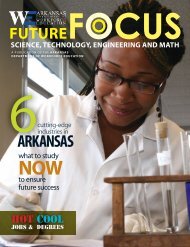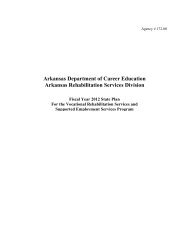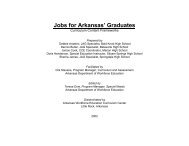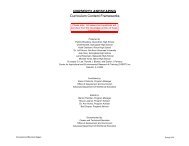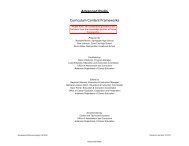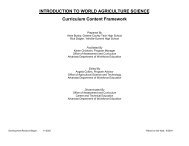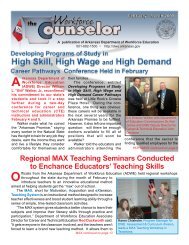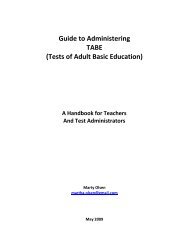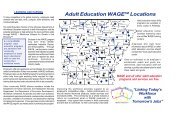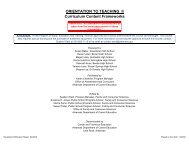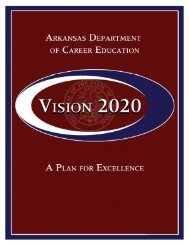Dance Technique I - Arkansas Department of Career Education
Dance Technique I - Arkansas Department of Career Education
Dance Technique I - Arkansas Department of Career Education
Create successful ePaper yourself
Turn your PDF publications into a flip-book with our unique Google optimized e-Paper software.
<strong>Dance</strong> <strong>Technique</strong> I<br />
Curriculum Content Frameworks<br />
Please note: All assessment questions will be<br />
taken from the knowledge portion <strong>of</strong> these<br />
frameworks.<br />
Prepared by<br />
M'Shay Callicott, Parkview High School<br />
Pamela Crane, Parkview High School<br />
Traci Presley, Mann Middle School<br />
Olympia Smith, Mann Middle School<br />
Michael Tidwell, Parkview High School<br />
Edited by<br />
Karen Chisholm, Program Manager<br />
Ray Henson, Program Manager<br />
Barbara Lensing, Program Advisor<br />
Dave Fisher, Program Advisor<br />
Office <strong>of</strong> <strong>Career</strong> Guidance, Exploration and Preparation<br />
<strong>Arkansas</strong> <strong>Department</strong> <strong>of</strong> Workforce <strong>Education</strong><br />
Disseminated by<br />
<strong>Career</strong> and Technical <strong>Education</strong><br />
Office <strong>of</strong> Assessment and Curriculum<br />
<strong>Arkansas</strong> <strong>Department</strong> <strong>of</strong> Workforce <strong>Education</strong><br />
Development/Revision Began: 03/2008<br />
Placed on the Web: 07/2011<br />
<strong>Dance</strong> <strong>Technique</strong> I
Grade Levels: 9, 10, 11, 12<br />
Course Code 559210<br />
Curriculum Content Frameworks<br />
<strong>Dance</strong> <strong>Technique</strong> I<br />
Prerequisite: Teacher Recommendation/Audition<br />
Course Description: <strong>Dance</strong> <strong>Technique</strong> I demonstrates basic dance techniques <strong>of</strong> various styles utilizing basic steps, positions, and patterns with the use <strong>of</strong> basic meters and<br />
rhythms; limited ranges. This is one <strong>of</strong> the core courses for a career major in the program <strong>of</strong> study called <strong>Dance</strong>. It is a year-long course that will introduce students to the<br />
elements <strong>of</strong> ballet, jazz, modern, and ethnic dance as the vehicle to the development <strong>of</strong> movement skills required <strong>of</strong> dancers as performing artists. Students will also develop<br />
the knowledge and strategies needed for incorporating a dancer's lifestyle.<br />
Table <strong>of</strong> Contents<br />
Page<br />
Unit 1: Performance and Exhibition <strong>of</strong> <strong>Dance</strong> 1<br />
Unit 2: Supplemental <strong>Dance</strong> History 5<br />
Unit 3: Critical and Aesthetic Evaluation 7<br />
Glossary 12<br />
<strong>Dance</strong> <strong>Technique</strong> I
Unit 1: Performance and Exhibition <strong>of</strong> <strong>Dance</strong><br />
Hours: 90<br />
Terminology: Alignment, Apron, Axial movement, Balance, Beat, Blocking, Center stage, Concert, Contraction, Cue, Direction, Downstage, Dress rehearsal, Elements, Elevation,<br />
Extension, Flexion, Focus, Force and Energy, Front <strong>of</strong> the house, House, Isolation, Locomotor movement, Mirror, Non-locomotor movement, Off-stage, Pathways, Personal space,<br />
Phrase, Proscenium, Pulse, Rehearsal, Release, Repetition, Run-through, Simple meters, Stage crew, Stage left, Stage right, Symmetrical, Syncopation, Upstage, Warm-up<br />
CAREER and TECHNICAL SKILLS<br />
What the Student Should be Able to Do<br />
ACADEMIC and WORKPLACE SKILLS<br />
What the Instruction Should Reinforce<br />
Knowledge Application Skill Group<br />
1.1 Define terminology<br />
1.1.1<br />
Spell, define and pronounce terminology<br />
correctly and appropriately<br />
Foundation<br />
Reading<br />
Skill<br />
Description<br />
Applies and understands technical words that<br />
pertain to performance and exhibition <strong>of</strong> dance<br />
[1.3.6]<br />
1.1.2 Apply dance terms appropriately<br />
1.2 Identify the appropriate 1.2.1 Exhibit secure hair<br />
pr<strong>of</strong>essional behavior and attire<br />
Foundation<br />
Personal<br />
Management<br />
Writing<br />
Self-Esteem<br />
Applies/Uses technical words and concepts<br />
related to dance [1.6.4]<br />
Create self-confidence and positive self-image<br />
through proper grooming [3.5.3]<br />
1.2.2 Identify appropriate class attire<br />
Personal<br />
Management<br />
Self-Esteem<br />
Comprehends the importance <strong>of</strong> a positive selfconcept<br />
[3.5.1]<br />
1.3 Describe the principles <strong>of</strong> body 1.3.1<br />
and movement<br />
1.2.3 Demonstrate acceptable dance etiquette Interpersonal Skills<br />
Exhibit various styles utilizing basic steps,<br />
positions, and patterns with the use <strong>of</strong><br />
basic meter rhythms with limited ranges<br />
Personal<br />
Management<br />
Personal<br />
Management<br />
Teamwork<br />
Responsibility<br />
Responsibility<br />
Demonstrates understanding, friendliness,<br />
adaptability, empathy, and politeness in new and<br />
ongoing group settings [2.6.3]<br />
Comprehends ideas and concepts related to<br />
dance technique [3.4.2]<br />
Pays close attention to details [3.4.8]<br />
1.3.2 Demonstrate appropriate basic skeletal Foundation Science<br />
alignment<br />
Applies scientific principals related to dance<br />
[1.4.5]<br />
Personal<br />
Management<br />
Responsibility<br />
Exerts a high level <strong>of</strong> effort and perseverance<br />
towards goal attainment [3.4.4]<br />
1.3.3 Demonstrate basic body part articulation Foundation Science<br />
Applies scientific principals related to dance<br />
[1.4.5]<br />
Personal<br />
Management<br />
Responsibility<br />
Exerts a high level <strong>of</strong> effort and perseverance<br />
towards goal attainment [3.4.4]<br />
<strong>Dance</strong> <strong>Technique</strong> I<br />
1
CAREER and TECHNICAL SKILLS<br />
What the Student Should be Able to Do<br />
ACADEMIC and WORKPLACE SKILLS<br />
What the Instruction Should Reinforce<br />
Knowledge Application Skill Group<br />
1.3.4 Demonstrate basic flexibility Foundation Science<br />
Skill<br />
Description<br />
Applies scientific principals related to dance<br />
[1.4.5]<br />
Personal<br />
Management<br />
Responsibility<br />
Exerts a high level <strong>of</strong> effort and perseverance<br />
towards goal attainment [3.4.4]<br />
1.3.5 Demonstrate basic locomotor and nonlocomotor<br />
Foundation Science<br />
movement<br />
Applies scientific principals related to dance<br />
[1.4.5]<br />
Personal<br />
Management<br />
Responsibility<br />
Exerts a high level <strong>of</strong> effort and perseverance<br />
towards goal attainment [3.4.4]<br />
1.3.6 Demonstrate basic agility Foundation Science<br />
Applies scientific principals related to dance<br />
[1.4.5]<br />
Personal<br />
Management<br />
Responsibility<br />
Exerts a high level <strong>of</strong> effort and perseverance<br />
towards goal attainment [3.4.4]<br />
1.3.7 Demonstrate basic strength Foundation Science<br />
Applies scientific principals related to dance<br />
[1.4.5]<br />
Personal<br />
Management<br />
Responsibility<br />
Exerts a high level <strong>of</strong> effort and perseverance<br />
towards goal attainment [3.4.4]<br />
1.3.8 Demonstrate basic coordination Foundation Science<br />
Personal<br />
Responsibility<br />
Management<br />
1.4 Identify the elements <strong>of</strong> dance 1.4.1 Apply space/time using basic movement Foundation Science<br />
1.4.2 Apply dynamics using basic movement Foundation Science<br />
1.4.3 Apply rhythm using basic movement Foundation Science<br />
Applies scientific principals related to dance<br />
[1.4.5]<br />
Exerts a high level <strong>of</strong> effort and perseverance<br />
towards goal attainment [3.4.4]<br />
Describes/Explains scientific principles related to<br />
dance [1.4.13]<br />
Describes/Explains scientific principles related to<br />
dance [1.4.13]<br />
Describes/Explains scientific principles related to<br />
dance [1.4.13]<br />
<strong>Dance</strong> <strong>Technique</strong> I<br />
2
CAREER and TECHNICAL SKILLS<br />
What the Student Should be Able to Do<br />
ACADEMIC and WORKPLACE SKILLS<br />
What the Instruction Should Reinforce<br />
Knowledge Application Skill Group<br />
1.5 Identify the principles <strong>of</strong> dance 1.5.1 Demonstrate technique and style<br />
Personal<br />
Management<br />
Skill<br />
Responsibility<br />
Description<br />
Pays close attention to details [3.4.8]<br />
1.5.2 Demonstrate improvisation and<br />
Thinking<br />
Seeing in the Mind's<br />
choreography<br />
Eye<br />
1.6 Name varied styles <strong>of</strong> dance 1.6.1 Identify varied dance styles within Foundation Speaking<br />
within performing arts/dance<br />
performing arts/dance<br />
1.7 Recognize the function <strong>of</strong> 1.7.1 Practice the rules and etiquette <strong>of</strong> the Interpersonal Skills Teamwork<br />
rehearsals and practice<br />
auditorium and rehearsal procedure<br />
sessions<br />
Imagines the flow <strong>of</strong> work activities from<br />
narrative descriptions [4.6.1]<br />
Interprets nonverbal cues such as eye contact,<br />
posture, and gestures for meaning [1.5.6]<br />
Demonstrates understanding, friendliness,<br />
adaptability, empathy, and politeness in new and<br />
ongoing group settings [2.6.3]<br />
Works effectively with others to reach a common<br />
goal [2.6.6]<br />
Displays high standards <strong>of</strong> attendance [3.4.5]<br />
Is punctual to class, school meetings, and work<br />
[3.4.6]<br />
1.7.2<br />
Perform the required steps through<br />
repetition<br />
Personal<br />
Management<br />
Responsibility<br />
Exhibits enthusiasm in approaching and<br />
completing tasks [3.4.3]<br />
Exerts a high level <strong>of</strong> effort and perseverance<br />
towards goal attainment [ 3.4.4]<br />
1.7.3 Accept constructive criticism Interpersonal Skills<br />
Personal<br />
Management<br />
Teamwork<br />
Organizational<br />
Effectiveness<br />
Recognizes effects <strong>of</strong> positive/negative attitudes<br />
on co-workers [2.6.4]<br />
Analyzes effectiveness <strong>of</strong> performance<br />
evaluation system [3.3.2]<br />
1.7.4 Reflect through self evaluation<br />
Personal<br />
Management<br />
Self-Esteem<br />
Presents positive image <strong>of</strong> personal attitudes<br />
and abilities [3.5.7]<br />
1.8 Identify the elements <strong>of</strong> the 1.8.1 Apply stage directions to basic movement Foundation Listening<br />
Listens to follow directions [ 1.2.6]<br />
stage<br />
during rehearsal and performance in<br />
various performance environments Personal<br />
Management<br />
Responsibility Maintains a high level <strong>of</strong> concentration in<br />
completion <strong>of</strong> a task [3.4.7]<br />
Sets high standards for self in completion <strong>of</strong> a<br />
task [3.4.9]<br />
<strong>Dance</strong> <strong>Technique</strong> I<br />
3
CAREER and TECHNICAL SKILLS<br />
What the Student Should be Able to Do<br />
ACADEMIC and WORKPLACE SKILLS<br />
What the Instruction Should Reinforce<br />
Knowledge Application Skill Group<br />
Skill<br />
Description<br />
1.9 Discuss safety, health, and 1.9.1 Demonstrate injury prevention,<br />
Foundation Science<br />
Follows safety guidelines [1.4.15]<br />
environmental issues related to identification, and treatment<br />
dance<br />
1.9.2 Demonstrate warm-up techniques Foundation Science<br />
Uses equipment and techniques in dance<br />
[1.4.23]<br />
Personal<br />
Management<br />
Self-Esteem<br />
Presents positive image <strong>of</strong> personal attitudes<br />
and abilities [3.5.7]<br />
1.9.3<br />
Demonstrate the importance <strong>of</strong> lifestyle<br />
choices in preparing for dance<br />
Personal<br />
Management<br />
Self-Esteem<br />
Develops/initiates a plan for self-improvement<br />
[3.5.4]<br />
1.9.4 Observe proper safety etiquette on Interpersonal Skills Coaching Comprehends ideas and concepts related to<br />
stage/in the studio<br />
dance [2.1.1]<br />
Personal<br />
Management<br />
Integrity/Honesty/<br />
Work Ethic<br />
Complies with safety and health rules in dance<br />
environment [3.2.2]<br />
<strong>Dance</strong> <strong>Technique</strong> I<br />
4
Terminology: Classical ballet, Ethnic dance, Folk, Jazz, Pantomime, Tap, <strong>Technique</strong><br />
Unit 2: Supplemental <strong>Dance</strong> History<br />
Hours: 10<br />
CAREER and TECHNICAL SKILLS<br />
What the Student Should be Able to Do<br />
ACADEMIC and WORKPLACE SKILLS<br />
What the Instruction Should Reinforce<br />
Knowledge<br />
Application<br />
Skill Group<br />
Skill<br />
2.1 Define terminology<br />
2.1.1 Apply terms appropriately within the Thinking<br />
Decision Making<br />
context <strong>of</strong> dance<br />
2.2 Explain the historical, cultural, 2.2.1 Review and discuss live, prerecorded, or Foundation Speaking<br />
and social context <strong>of</strong> dance<br />
historical performances<br />
2.2.2 Discuss local dance artists relevant to the Interpersonal Skills Cultural Diversity<br />
community<br />
2.3 Identify the types <strong>of</strong> dance in 2.3.1 Recognize a ritual dance Foundation Speaking<br />
history<br />
Description<br />
Comprehends ideas and concepts related to<br />
supplemental dance history. [4.2.2]<br />
Uses verbal language and other cues such as<br />
body language appropriate in style, tone, and<br />
level <strong>of</strong> complexity to the audience and the<br />
occasion [1.5.14]<br />
Discusses contributions and innovations made<br />
by women and/or minority groups [2.2.2]<br />
Communicates a thought, idea, or fact in spoken<br />
form [1.5.5]<br />
Foundation<br />
Writing Applies technical words and concepts [1.6.4]<br />
Thinking<br />
Problem Solving<br />
Devises and implements a plan <strong>of</strong> action to<br />
resolve a problem [4.4.3]<br />
2.3.2 Recognize a social dance Foundation Speaking<br />
Communicates a thought, idea, or fact in spoken<br />
form [1.5.5]<br />
Foundation<br />
Writing Applies technical words and concepts [1.6.4]<br />
Thinking<br />
Problem Solving<br />
Devises and implements a plan <strong>of</strong> action to<br />
resolve a problem [4.4.3]<br />
2.3.3 Recognize a theatrical dance Foundation Speaking<br />
Communicates a thought, idea, or fact in spoken<br />
form [1.5.5]<br />
Foundation<br />
Writing Applies technical words and concepts [1.6.4]<br />
Thinking<br />
2.3.4 Identify ritual, social, and theatrical dance Thinking<br />
by geographical region<br />
Problem Solving<br />
Problem Solving<br />
Devises and implements a plan <strong>of</strong> action to<br />
resolve a problem [4.4.3]<br />
Draws conclusions from observations, evaluates<br />
conditions, and gives possible solutions [4.4.5]<br />
<strong>Dance</strong> Tequnique I<br />
5
CAREER and TECHNICAL SKILLS<br />
What the Student Should be Able to Do<br />
ACADEMIC and WORKPLACE SKILLS<br />
What the Instruction Should Reinforce<br />
Knowledge<br />
Application<br />
Skill Group<br />
Skill<br />
Description<br />
2.4 Identify different periods in 2.4.1 Discuss the Pre-Classical period Foundation Speaking<br />
Ask questions to obtain information [1.5.4]<br />
dance history<br />
Organizes ideas and communicates oral<br />
messages to listeners [1.5.7]<br />
Personal<br />
Management<br />
Responsibility<br />
Comprehends ideas and concepts related to<br />
dance [3.4.2]<br />
2.4.2 Discuss the Romantic period Foundation Speaking<br />
Ask questions to obtain information [1.5.4]<br />
Organizes ideas and communicates oral<br />
messages to listeners [1.5.7]<br />
Personal<br />
Management<br />
Responsibility<br />
Comprehends ideas and concepts related to<br />
dance [3.4.2]<br />
2.4.3 Discuss the New Age <strong>of</strong> Ballet Foundation Speaking<br />
Ask questions to obtain information [1.5.4]<br />
Organizes ideas and communicates oral<br />
messages to listeners [1.5.7]<br />
Personal<br />
Management<br />
Responsibility<br />
Comprehends ideas and concepts related to<br />
dance [3.4.2]<br />
2.4.4 Compare and contrast different periods in Foundation Writing<br />
dance history<br />
Presents answers/conclusions in a clear and<br />
understandable form [1.6.13]<br />
Thinking<br />
Thinking<br />
Problem Solving<br />
Reasoning<br />
Demonstrates logical reasoning in reaching a<br />
conclusion [4.4.2]<br />
See relationship between two or more ideas,<br />
objects, or situations [4.5.5]<br />
<strong>Dance</strong> Tequnique I<br />
6
Unit 3: Critical and Aesthetic Evaluation<br />
Hours: 10<br />
Terminology: Actions, Asymmetrical, Choreography, Critique, Dynamics, Expressive, Level, Musicality, Percussive movements, Performance, Props, Shape, Style, Unison<br />
CAREER and TECHNICAL SKILLS<br />
What the Student Should be Able to Do<br />
ACADEMIC and WORKPLACE SKILLS<br />
What the Instruction Should Reinforce<br />
Knowledge<br />
3.1 Define terminology<br />
3.1.1 Apply terms appropriately within context <strong>of</strong> Thinking<br />
dance<br />
3.2 Examine critical choreographic 3.2.1 Establish aesthetic criteria to include body Thinking<br />
processes in performing<br />
levels, shapes and pathways<br />
arts/dance<br />
Application Skill Group Skill Description<br />
Decision Making<br />
Creative Thinking<br />
Problem Solving<br />
Comprehends ideas and concepts related to<br />
critical and aesthetic evaluation. [4.2.2]<br />
Combines ideas or information in a new way<br />
[4.1.2]<br />
Draws conclusions from observations, evaluates<br />
conditions, and gives possible solutions [4.4.5]<br />
Problem Solving Visualizes a finished product [4.6.4]<br />
3.3 List the other art forms that 3.3.1 Identify music that supports or collaborates Foundation Listening<br />
Listens for emotional meaning [1.2.5]<br />
support or collaborate with<br />
with dance<br />
dance<br />
Thinking<br />
Reasoning See relationship between two or more ideas,<br />
objects, or situations [4.5.5]<br />
3.3.2 Identify theatrical sets that support or Foundation Speaking<br />
collaborate with dance<br />
Communicates a thought, idea, or fact in spoken<br />
form [1.5.5]<br />
Thinking<br />
Reasoning<br />
See relationship between two or more ideas,<br />
objects, or situations [4.5.5]<br />
3.3.3 Identify costumes that support or<br />
Foundation Speaking<br />
collaborate with dance<br />
Communicates a thought, idea, or fact in spoken<br />
form [1.5.5]<br />
Thinking<br />
Reasoning<br />
See relationship between two or more ideas,<br />
objects, or situations [4.5.5]<br />
3.3.4 Identify theatrical effects that collaborate Foundation Speaking<br />
with dance<br />
Communicates a thought, idea, or fact in spoken<br />
form [1.5.5]<br />
Thinking<br />
Reasoning<br />
See relationship between two or more ideas,<br />
objects, or situations [4.5.5]<br />
<strong>Dance</strong> <strong>Technique</strong> I<br />
7
CAREER and TECHNICAL SKILLS<br />
What the Student Should be Able to Do<br />
ACADEMIC and WORKPLACE SKILLS<br />
What the Instruction Should Reinforce<br />
Knowledge Application Skill Group Skill Description<br />
3.3.5 Discuss the interdependence <strong>of</strong> the related Foundation Writing<br />
art forms to dance<br />
Communicates thoughts, ideas, or facts in<br />
written form in a clear, concise manner [1.6.6]<br />
Thinking<br />
3.4 Identify performing arts/dance 3.4.1 Discuss responses to written and oral Thinking<br />
examples<br />
statements about dance<br />
Reasoning<br />
Decision Making<br />
Knowing how to<br />
Learn<br />
See relationship between two or more ideas,<br />
objects, or situations [4.5.5]<br />
Comprehends ideas and concepts related to<br />
dance [4.2.2]<br />
Locates appropriate learning resources to<br />
acquire or improve knowledge and skills [4.3.3]<br />
Knowing how to<br />
Learn<br />
3.5 Construct a critical statement on 3.5.1 Justify response based on basic<br />
Foundation Writing<br />
the meaning <strong>of</strong> a dance<br />
knowledge and personal preferences<br />
Processes new information as related to dance<br />
[4.3.5]<br />
Communicates thoughts, ideas, or facts in<br />
written form in a clear, concise manner [1.6.6]<br />
Presents answers/conclusions in a clear and<br />
understandable form [1.6.13]<br />
Presents own opinion in written form in a clear,<br />
concise manner [1.6.14]<br />
3.5.2 Compare/contrast response Interpersonal Skills Coaching<br />
Encourages others to develop personal and<br />
pr<strong>of</strong>essional skills [2.1.2]<br />
3.6 Discuss the theme <strong>of</strong> a dance 3.6.1<br />
observed live or on video<br />
Describe how the choreographer’s<br />
movement choices communicate ideas<br />
throughout the dance<br />
Helps others learn new skills [2.1.3]<br />
Interpersonal Skills Teamwork Comprehends ideas and concepts related to<br />
dance [2.6.1]<br />
3.6.2<br />
Discuss how the music, set, costumes, and<br />
effects relate to the choreographer’s<br />
movement choices to further develop the<br />
theme <strong>of</strong> the dance composition<br />
Interpersonal Skills Teamwork Comprehends ideas and concepts related to<br />
dance [2.6.1]<br />
Contributes to group with ideas, suggestions,<br />
and effort [2.6.2]<br />
Works effectively with others to reach a common<br />
goal [2.6.6]<br />
<strong>Dance</strong> <strong>Technique</strong> I<br />
8
Unit 4: <strong>Career</strong> Development<br />
Hours: 10<br />
Terminology: Aptitude, Budget, <strong>Career</strong> portfolio, Collaboration, Communication skills, Competency, Compromise, Confidentiality, Conflict resolution, Cooperation, Dependability,<br />
Fringe benefits, Goals, Gross income, Initiative, Interest inventory, Kuder, Letter <strong>of</strong> recommendation, Net income, Performance evaluation, Personal management, Policy,<br />
Punctuality, Reliability, Respect, Responsibility, Resume, Scholarship, Self discipline, Social Security, Time management, Work ethic, Workforce diversity<br />
CAREER and TECHNICAL SKILLS<br />
ACADEMIC and WORKPLACE SKILLS<br />
What the Student Should be Able to Do<br />
What the Instruction Should Reinforce<br />
Knowledge Application Skill Group Skill Description<br />
4.1 Define terminology<br />
3.1.1 Apply terms appropriately within context Thinking<br />
Decision Making Comprehends ideas and concepts related to<br />
<strong>of</strong> dance<br />
career development in dance [4.2.2]<br />
4.2 Develop a personal dance 3.2.1 State the objectives <strong>of</strong> developing a Foundation Writing Communicates thoughts, ideas, or facts in<br />
career portfolio<br />
personal dance career portfolio<br />
written form in a clear, concise manner [1.6.6]<br />
3.2.2 State the purpose <strong>of</strong> developing a Foundation Writing<br />
personal dance career portfolio<br />
Communicates thoughts, ideas, or facts in<br />
written form in a clear, concise manner [1.6.6]<br />
3.2.3<br />
Assess personal values, knowledge,<br />
aptitudes, skills, interests, experience,<br />
and accomplishments<br />
Personal<br />
Management<br />
<strong>Career</strong> Awareness<br />
Analyzes own knowledge, skills, and abilities<br />
[3.1.2]<br />
3.2.4 Use Kuder, KeyTrain, and/or other Thinking<br />
resources to match personal qualities<br />
with career opportunities<br />
Knowing how to<br />
learn<br />
Locates appropriate learning resources to<br />
acquire or improve knowledge and skills [4.3.3]<br />
Explores career opportunities [3.1.6]<br />
3.2.5<br />
Set realistic and measurable personal<br />
and pr<strong>of</strong>essional goals (short-term and<br />
long-term)<br />
Personal<br />
Management<br />
Self-Esteem<br />
Sets well-defined and realistic personal and<br />
career goals (short-term and long-term) [3.1.11]<br />
Analyzes impact <strong>of</strong> work on individual and family<br />
life [3.1.1]<br />
4.3 Establish post-secondary<br />
education/training plan<br />
3.3.1 Verify and document post-secondary<br />
options and opportunities<br />
Thinking<br />
Knowing How to<br />
Learn<br />
3.3.2 Determine educational and training<br />
needed to meet career goal<br />
Personal<br />
Management<br />
<strong>Career</strong> Awareness,<br />
Development, and<br />
requirements<br />
Mobility<br />
3.3.3 Write an education/training plan to reach<br />
Self-Esteem<br />
goals<br />
Monitors progress toward goal attainment<br />
[3.1.10]<br />
Locates appropriate learning resources to<br />
acquire or improve knowledge and skills [4.3.3]<br />
Identifies education and training needed to<br />
achieve goals [3.1.8]<br />
Develops and initiates a plan for selfimprovement<br />
[3.5.4]<br />
<strong>Dance</strong> <strong>Technique</strong> 1<br />
9
CAREER and TECHNICAL SKILLS<br />
ACADEMIC and WORKPLACE SKILLS<br />
What the Student Should be Able to Do<br />
What the Instruction Should Reinforce<br />
Knowledge Application Skill Group Skill Description<br />
4.4 Critique personal traits <strong>of</strong> an 3.4.1<br />
effective dancer<br />
Discuss/analyze work ethic and worker<br />
habits <strong>of</strong> a pr<strong>of</strong>essional dancer<br />
Personal<br />
Management<br />
Integrity/Honesty/<br />
Work Ethic<br />
Describes desirable worker characteristics [3.2.3]<br />
Describes/explains significance <strong>of</strong> integrity,<br />
honesty, and work ethics [3.2.4]<br />
3.4.2<br />
Compare/contrast worker attitudes for<br />
worker morale<br />
Interpersonal Skills Teamwork Recognizes effects <strong>of</strong> positive and negative<br />
attitudes on co-workers [2.6.4]<br />
3.4.3<br />
4.5 Describe what dance company 3.5.1<br />
directors expect <strong>of</strong> dancers<br />
Demonstrate admirable personal<br />
qualities <strong>of</strong> an effective dance company<br />
Discuss anticipated problems in meeting<br />
director's expectations<br />
Personal<br />
Management<br />
Work Habits<br />
Demonstrates understanding, friendliness,<br />
adaptability, empathy, and politeness in new and<br />
ongoing group settings [2.6.3]<br />
Presents positive image <strong>of</strong> personal attitudes<br />
and abilities [3.5.7]<br />
3.5.2<br />
4.6 Identify standard policies, rules, 3.6.1<br />
regulations, and ethics used in<br />
the workplace<br />
3.6.2<br />
Recommend realistic employer<br />
expectations<br />
Discuss standard policy, rules, and<br />
regulations a workplace setting<br />
Identify standard operation procedures<br />
and safety practices<br />
Personal<br />
Management<br />
Personal<br />
Management<br />
Organizational<br />
Effectiveness<br />
Integrity/Honesty/<br />
Work Ethic<br />
Integrity/Honesty/<br />
Work Ethic<br />
Adapts to organizational goals [3.3.1]<br />
Follows established rules, regulations, and<br />
policies [3.2.5]<br />
Complies with safety and health rules in a given<br />
work environment [3.2.2]<br />
4.7 Identify proper communication 3.7.1<br />
etiquette in the workplace<br />
Demonstrate appropriate person-toperson<br />
etiquette<br />
Organizational Comprehends the organization's modes <strong>of</strong><br />
Effectiveness operation [3.3.5]<br />
Interpersonal Customer Service Demonstrates face-to-face selling skills [2.3.3]<br />
3.7.2 Demonstrate appropriate group and<br />
Speaking<br />
meeting etiquette<br />
Uses verbal language and other cues such as<br />
body language appropriate in style, tone, and<br />
level <strong>of</strong> complexity to the audience and the<br />
occasion [1.5.14]<br />
4.8 Complete appropriate<br />
3.8.1<br />
documents for job application<br />
Type a letter <strong>of</strong> application for a career<br />
goal<br />
Personal<br />
Management<br />
Self-Esteem<br />
Creates a positive self-image by selling self in a<br />
letter <strong>of</strong> application [3.5.2]<br />
3.8.2 Complete a job application form Foundation Writing<br />
Produces neat, legible document from typewriter<br />
correctly and accurately<br />
or computer [1.6.15]<br />
Writing Completes form accurately [1.6.7]<br />
3.8.3 Complete a resume for a career goal Personal<br />
Self Esteem Develops self-confidence by creating a resume,<br />
Management<br />
which promotes personal strengths and abilities<br />
[3.5.5]<br />
Identifies personality assets [3.5.6]<br />
<strong>Dance</strong> <strong>Technique</strong> 1<br />
10
CAREER and TECHNICAL SKILLS<br />
ACADEMIC and WORKPLACE SKILLS<br />
What the Student Should be Able to Do<br />
What the Instruction Should Reinforce<br />
Knowledge Application Skill Group Skill Description<br />
3.8.4<br />
4.9 Describe appropriate<br />
3.9.1<br />
appearance in the studio,<br />
performance and benefit<br />
following performance<br />
Type a follow-up letter for a career goal Responsibility Exerts a high level <strong>of</strong> effort and perseverance<br />
towards goal attainment [3.4.4]<br />
Analyze dancer's compliance with the Thinking Reasoning Uses logic to draw conclusions from available<br />
company's dress code and appearance<br />
information [4.5.6]<br />
standards to be a successful company<br />
member<br />
3.9.2 Demonstrate appropriate attire for an Personal<br />
Self Esteem<br />
interview<br />
Management<br />
4.10 Evaluate interview<br />
3.10.1 Identify, prepare, and present answers Foundation Speaking<br />
competencies<br />
to most frequently-asked interview<br />
questions<br />
Creates self-confidence and positive self-image<br />
through proper grooming [3.5.3]<br />
Speaks effectively, using appropriate eye<br />
contact, gestures, and posture [1.5.11]<br />
Personal<br />
Management<br />
Self Esteem<br />
Presents positive image <strong>of</strong> personal attitudes<br />
and abilities [3.5.7]<br />
Presents positive personal reference <strong>of</strong><br />
education and work experience [3.5.8]<br />
3.11 Assess employment<br />
3.11.1 Calculate net pay Foundation Math<br />
Calculates and estimates payroll deductions<br />
compensation and benefits<br />
[1.1.8]<br />
3.11.2 Assess personal needs and calculate Thinking<br />
payroll deductions and its impact on<br />
lifestyle and future needs<br />
3.11.3 Critique forms <strong>of</strong> pay and justify Thinking<br />
personal preference for earnings<br />
Decision Making<br />
Reasoning<br />
Evaluates information and data needed to make<br />
best decision [4.2.5]<br />
Use logic to draw conclusions from available<br />
information [4.5.6]<br />
<strong>Dance</strong> <strong>Technique</strong> 1<br />
11
1. Alignment – The relationship <strong>of</strong> the skeleton to the line <strong>of</strong> gravity and the base <strong>of</strong> support. Body placement/posture<br />
2. Apron – The front or most downstage area <strong>of</strong> the stage<br />
Glossary<br />
Unit 1: Performance and Exhibition <strong>of</strong> <strong>Dance</strong><br />
3.<br />
Axial movement – Any movement that is anchored to one spot by a body part using only the available space in any direction without losing the initial body contact. Also known as<br />
non-locomotor movement<br />
4. Balance – A state <strong>of</strong> equilibrium referring to the distribution <strong>of</strong> weight or the special arrangement <strong>of</strong> bodies<br />
5. Beat – A steady pulse<br />
6. Blocking – The planning and working out <strong>of</strong> the movements on stage<br />
7. Center stage – The center <strong>of</strong> the performing area<br />
8. Concert – A program <strong>of</strong> separate dances organized into a single performance<br />
9. Contraction – The tightening <strong>of</strong> a muscle causing it to become shorter and thicker<br />
10. Cue – A signal, either verbal or physical, that indicates something else, such as a line <strong>of</strong> dialogue or an entrance, is to happen<br />
11. Direction – The path produced by moving, and the apparent line toward which someone is pointing or facing<br />
12. Downstage – The stage area toward the audience<br />
13. Dress rehearsal – The practice session or run through immediately preceding the performance in which the dancers wear their costumes<br />
14. Elements – The use <strong>of</strong> the body moving in space and time with force/energy<br />
15. Elevation – The body’s propulsion into the air away from the floor, such as in a leap, hop, or jump<br />
16. Extension – The straightening <strong>of</strong> a body part<br />
17. Flexion – The bending <strong>of</strong> a body part<br />
18. Focus – The conscious attention toward a converging point<br />
19.<br />
Force and Energy – An element <strong>of</strong> dance characterized by the release <strong>of</strong> potential energy into kinetic energy. It utilizes body weight, reveals the effects <strong>of</strong> gravity on the body, is<br />
projected into space, and effects emotional and spatial relationships and intensions. The most recognized qualities <strong>of</strong> movement are sustained, percussive, suspended,<br />
<strong>Dance</strong> <strong>Technique</strong> I<br />
9
20. Front <strong>of</strong> the house – Box <strong>of</strong>fice and lobby<br />
21. House – The area <strong>of</strong> the theatre in which the audience is seated<br />
22. Isolation – Movements restricted to one area <strong>of</strong> the body such as the shoulders, rib cage or hips<br />
23. Locomotor movement – Traveling from one place to another<br />
24. Mirror – To copy the movements <strong>of</strong> another while facing the individual<br />
25. Non-locomotor movement – An “in place” movement performed on a fixed base<br />
26. Off stage – Situated or taking place in the area <strong>of</strong> a stage not visible to the audience<br />
27. Pathways – A line along which a person or a part <strong>of</strong> the person, such as an arm or head, moves (e.g., her arm took a circular path, or he traveled along a zigzag pathway)<br />
28.<br />
Personal space – The “space bubble” or the kinesphere that one occupies; it includes all levels, planes, and directions both near and far from the body’s center. Also known as<br />
self space<br />
29. Phrase – A rhythmic or movement unit – ordered, progressive, and proportioned in form<br />
30. Proscenium – The enlarged hole cut through a wall to allow the audience to view the stage, also called the proscenium arch<br />
31. Pulse – The underlying and consistent beat<br />
32. Rehearsal – Practice sessions in which the dancers and technicians prepare for public performance through repetition<br />
33. Release – A relaxation <strong>of</strong> contracted muscles while maintaining decided control<br />
34. Repetition – That which repeats in order to clarify and emphasize<br />
35. Run-through – A rehearsal moving from start to finish without stopping for corrections or notes<br />
36. Simple meters – Units <strong>of</strong> two or three with a strong accent on the first beat <strong>of</strong> the measure<br />
37. Stage crew – The backstage technical crew responsible for running the show<br />
38. Stage left – The left side <strong>of</strong> the stage from the perspective <strong>of</strong> an actor facing the audience<br />
39. Stage right – The right side <strong>of</strong> the stage from the perspective <strong>of</strong> an actor facing the audience<br />
40. Symmetrical – A visually balanced body shape or grouping <strong>of</strong> dancers<br />
41. Syncopation – Accenting a weak beat or an unaccented part <strong>of</strong> a beat<br />
42. Upstage – Used as a noun, the stage area away from the audience; used as a verb, to steal the focus <strong>of</strong> a scene<br />
43. Warm-up – Movements and/or movement phrases designed to raise the core body temperature and bring the mind into focus for the dance activities to follow<br />
<strong>Dance</strong> <strong>Technique</strong> I<br />
10
Unit 2: Supplemental <strong>Dance</strong> History<br />
1.<br />
Classical ballet – A dance form that includes the traditional steps, positions, and body carriage that originated before the 20th century; also refers to a dance presentation<br />
choreographed prior to the 20th century<br />
2. Ethnic dance – <strong>Dance</strong> which portrays authentic and historical elements <strong>of</strong> a culture<br />
3. Folk – <strong>Dance</strong>s that are usually created and performed by a specific group within a culture<br />
4. Jazz – Any <strong>of</strong> various dances characterized by the use <strong>of</strong> improvisation and influenced by rhythms and techniques <strong>of</strong> jazz music.<br />
5. Pantomime – A non verbal but realistic use <strong>of</strong> action and gesture as a means <strong>of</strong> expression.<br />
6.<br />
Tap – A more intricate and sophisticated form <strong>of</strong> clog dance; with its roots based in traditional Irish step dances, from Spanish flamenco dances and from the footwork <strong>of</strong> many<br />
African dances<br />
7. <strong>Technique</strong> – The skill essential to the components <strong>of</strong> performance<br />
<strong>Dance</strong> <strong>Technique</strong> I<br />
11
Unit 3: Critical and Aesthetic Evaluation<br />
1. Actions – What the body is doing. Includes locomotor and non-locomotor movements; for example, running, jumping, twisting, gesturing, turning<br />
2. Asymmetrical – Unbalanced, as applies to a body shape or grouping <strong>of</strong> dancers<br />
3. Choreography – The art <strong>of</strong> composing dances<br />
4. Critique – Opinions and comment based on predetermined criteria that may be used for self evaluation or the evaluation <strong>of</strong> the dancers or the production itself<br />
5. Dynamics – The force <strong>of</strong> movement with variations in the amounts <strong>of</strong> power, intensity and energy exerted<br />
6. Expressive – The elements <strong>of</strong> art used to elicit feelings; such as, anger, joy, sadness, power, weakness, etc<br />
7. Level – Gradations <strong>of</strong> height from the floor to the highest possible elevation<br />
8. Musicality – The attention and sensitivity to the musical elements <strong>of</strong> dance while creating or performing<br />
9. Percussive movements – A sharp, forceful and ballistic type <strong>of</strong> movement with a marked initial impetus which later is quickly checked on the follow-through<br />
10. Performance – Skillful presentation in which communication occurs<br />
11. Props – Items carried on stage by a performer<br />
12.<br />
Shape – An interesting and interrelated arrangement <strong>of</strong> body parts <strong>of</strong> one dancer; the visible makeup or molding <strong>of</strong> the body parts <strong>of</strong> a single dancer; the overall visible<br />
appearance <strong>of</strong> a group <strong>of</strong> dancers; also, the overall development or form <strong>of</strong> a dance<br />
13. Style – A distinctive manner <strong>of</strong> moving; the characteristic way dance is done, created, or performed that identifies the dance <strong>of</strong> a particular performer, choreographer, or period<br />
14. Unison -- <strong>Dance</strong> movement that takes place at the same time in a group<br />
<strong>Dance</strong> <strong>Technique</strong> I<br />
12
Unit 4: <strong>Career</strong> Development<br />
1. Aptitude -- One's potential for learning a new skill<br />
2. Budget -- An itemized list <strong>of</strong> expected income and expense for a given period in the future<br />
3.<br />
<strong>Career</strong> portfolio -- An organizational tool used to document personal growth toward a career goal containing assessments, interest inventories, work samples, education, skills,<br />
goals, and plans used to apply to college, training programs, or job applications<br />
4. Collaboration -- To work jointly with others<br />
5. Communication Skills -- The ability to convey a message through various forms and receive feedback<br />
6. Competency -- Measureable skills and abilities that an employee possesses in order to excel in a particular job.<br />
7. Compromise -- Each party in a disagreement is willing to give in order to receive<br />
8. Confidentiality -- Discretion in keeping secret or private information<br />
9. Conflict resolution -- The settling <strong>of</strong> differences so people may work together effectively<br />
10. Cooperation -- A combination <strong>of</strong> people working together for mutual benefit<br />
11. Dependability -- The quality <strong>of</strong> being reliable and trustworthy<br />
12. Fringe benefit -- An employee benefit given in addition to one's wages or salary<br />
13. Goals -- short/medium/long term - Pr<strong>of</strong>essional objectives in which an employee plans to achieve in a specific period <strong>of</strong> time<br />
14. Gross income -- Total pay, excluding all deductions<br />
15. Initiative -- The power or ability to begin or to follow through energetically with a plan or task.<br />
16. Interest inventory -- A document designed to help determine specific personal preferences related to work or leisure<br />
17. Kuder -- A comprehensive online tool with self assessment resources, education planning, and occupation exploration features to help students with their career development<br />
18.<br />
Letter <strong>of</strong> recommendation -- A written document that assesses the qualities, characteristics, and capabilities <strong>of</strong> a person, which is typically related to employment, college<br />
program admission, or scholarship eligibility<br />
19. Net income -- The amount <strong>of</strong> pay a person receives after all deductions are subtracted<br />
20. Performance evaluation -- An examination or judgment <strong>of</strong> an employee's work efficiency<br />
21. Personal management -- A self awareness and management process to develop skills necessary to maximize personal growth<br />
<strong>Dance</strong> <strong>Technique</strong> I<br />
13
22. Policy -- A deliberate plan <strong>of</strong> action to guide decisions<br />
23. Punctuality -- Strict observance in arriving to engagements on time; promptness<br />
24. Reliability -- Someone who is dependable in achievement, accuracy, honesty, etc.<br />
25. Respect -- The condition <strong>of</strong> being honored or esteemed<br />
26. Responsibility -- The state <strong>of</strong> being reliable or dependable<br />
27. Resume -- A formal document that sums up a person's work qualifications, character, and dependability<br />
28. Scholarship -- A sum <strong>of</strong> money or other aid granted to a student, because <strong>of</strong> merit, need, etc., to pursue his or her studies<br />
29. Self-discipline -- Training oneself to improve behavior to comply with employer expectations<br />
30.<br />
Social Security -- A program <strong>of</strong> old-age, unemployment, health, disability, and survivors insurance maintained by the U.S. federal government through compulsory payments by<br />
employers and employee groups<br />
31. Time management -- Tools or techniques used for planning and scheduling time, usually with the aim to increase effectiveness and/or efficiency.<br />
32. Work ethic -- Set <strong>of</strong> values based on the moral virtues <strong>of</strong> hard work and diligence<br />
33. Workforce diversity -- Differences among employees in the workplace<br />
<strong>Dance</strong> <strong>Technique</strong> I<br />
14



